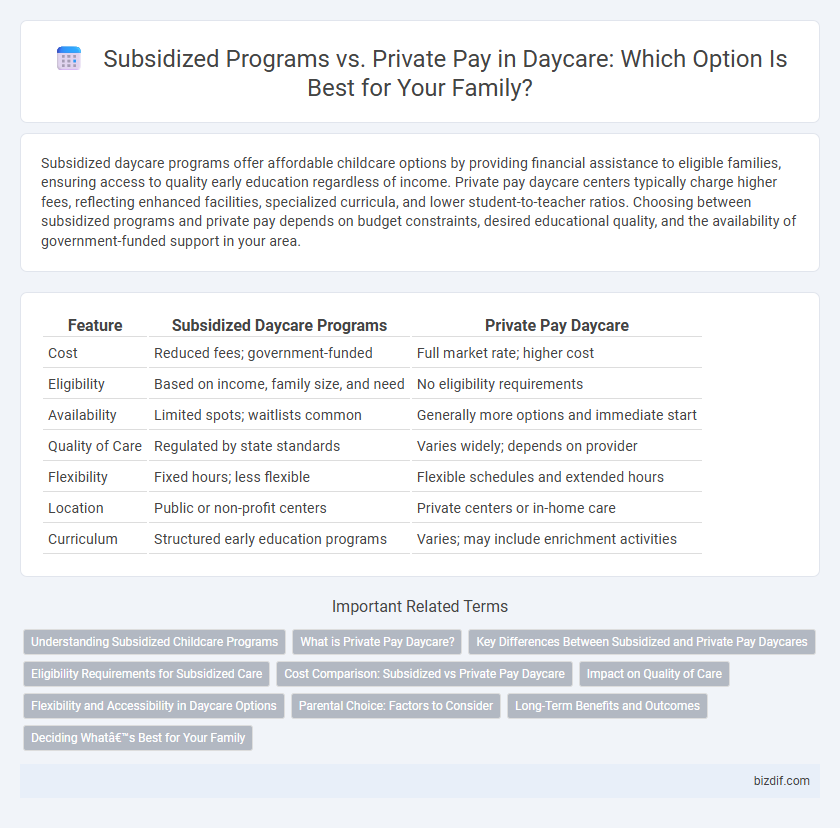Subsidized daycare programs offer affordable childcare options by providing financial assistance to eligible families, ensuring access to quality early education regardless of income. Private pay daycare centers typically charge higher fees, reflecting enhanced facilities, specialized curricula, and lower student-to-teacher ratios. Choosing between subsidized programs and private pay depends on budget constraints, desired educational quality, and the availability of government-funded support in your area.
Table of Comparison
| Feature | Subsidized Daycare Programs | Private Pay Daycare |
|---|---|---|
| Cost | Reduced fees; government-funded | Full market rate; higher cost |
| Eligibility | Based on income, family size, and need | No eligibility requirements |
| Availability | Limited spots; waitlists common | Generally more options and immediate start |
| Quality of Care | Regulated by state standards | Varies widely; depends on provider |
| Flexibility | Fixed hours; less flexible | Flexible schedules and extended hours |
| Location | Public or non-profit centers | Private centers or in-home care |
| Curriculum | Structured early education programs | Varies; may include enrichment activities |
Understanding Subsidized Childcare Programs
Subsidized childcare programs provide financial assistance to low-income families, making quality daycare more accessible by covering partial or full costs based on eligibility criteria such as income level and family size. These programs often follow state or federal guidelines, ensuring regulated standards and affordability, unlike private pay daycare which requires full out-of-pocket payment and may offer more flexible or premium services. Understanding the distinction helps families identify cost-saving opportunities while ensuring their children receive appropriate early education and care.
What is Private Pay Daycare?
Private pay daycare refers to childcare services funded entirely by parents or guardians without government subsidies, offering more flexibility in program choice, hours, and personalized care options. These programs often provide enhanced facilities, specialized curricula, and lower child-to-caregiver ratios compared to subsidized alternatives. Families choosing private pay daycare prioritize quality, convenience, and tailored experiences despite higher out-of-pocket costs.
Key Differences Between Subsidized and Private Pay Daycares
Subsidized daycare programs offer reduced fees based on family income and government eligibility, ensuring affordable childcare for low- to moderate-income households. Private pay daycares charge full tuition rates without income restrictions, often providing more diverse programming, flexible hours, and enhanced facilities. The key differences include cost, enrollment criteria, and available resources, which directly affect accessibility and quality of care.
Eligibility Requirements for Subsidized Care
Subsidized daycare programs require families to meet specific eligibility criteria, typically based on income thresholds, family size, and employment or educational status to qualify for financial assistance. These programs prioritize low-income households to ensure affordable access to quality childcare, often involving verification of documents such as tax returns, pay stubs, or proof of public assistance. Private pay daycare centers do not have these eligibility restrictions, offering services at set rates without financial aid.
Cost Comparison: Subsidized vs Private Pay Daycare
Subsidized daycare programs significantly reduce out-of-pocket expenses by covering a large portion of childcare costs through government funding, making them affordable for low- to moderate-income families. Private pay daycare typically involves higher fees, which can range from $800 to $1,200 per month depending on location and services offered, positioning it as a premium option with greater flexibility and amenities. Families must weigh the financial relief of subsidized care against the customized options often available through private pay centers.
Impact on Quality of Care
Subsidized daycare programs often provide more consistent quality standards due to government regulations and funding requirements, ensuring access to trained staff and enriched learning environments. Private pay daycare centers may offer more flexibility and additional amenities, but quality can vary significantly based on the provider's resources and management. Research indicates that subsidized programs generally maintain higher overall care quality through structured oversight and standardized curriculum implementation.
Flexibility and Accessibility in Daycare Options
Subsidized daycare programs offer greater accessibility by providing lower-cost options for low-income families, often with waiting lists and limited hours that reduce flexibility. Private pay daycare centers typically provide more flexible scheduling, including extended hours and drop-in care, catering to working parents with varied needs. Families prioritizing affordability may choose subsidized programs, while those seeking adaptable hours often opt for private pay services to match their work and lifestyle demands.
Parental Choice: Factors to Consider
Parents weigh factors such as affordability, quality of care, and program flexibility when choosing between subsidized daycare programs and private pay options. Subsidized programs often provide financial relief and access to state-regulated standards, while private pay centers may offer customized schedules and specialized curricula. Considering these elements helps parents align childcare decisions with family needs and long-term goals.
Long-Term Benefits and Outcomes
Subsidized daycare programs provide affordable early childhood education, promoting equal access that supports cognitive and social development across diverse populations. Private pay daycare often offers enhanced resources and lower child-to-staff ratios, potentially leading to higher individualized attention and tailored learning experiences. Long-term benefits of subsidized programs include improved school readiness and reduced achievement gaps, while private pay options may foster advanced skill development and early enrichment opportunities.
Deciding What’s Best for Your Family
Subsidized daycare programs offer affordable childcare options based on income eligibility, providing financial relief and access to quality early education for low-to-moderate-income families. Private pay daycare centers typically offer greater flexibility, specialized curricula, and extended hours, catering to families who prioritize customized care and can afford higher fees. Evaluating your family's budget, childcare needs, location, and long-term goals ensures choosing the best daycare solution that balances cost, quality, and convenience.
Subsidized programs vs Private pay Infographic

 bizdif.com
bizdif.com